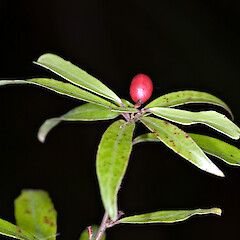Alseuosmia banksii var. linariifolia
Synonyms
Alseuosmia linariifolia
Family
Alseuosmiaceae
Flora category
Vascular – Native
Endemic taxon
Yes
Endemic genus
Yes
Endemic family
No
Structural class
Trees & Shrubs - Dicotyledons
NVS code
The National Vegetation Survey (NVS) Databank is a physical archive and electronic databank containing records of over 94,000 vegetation survey plots - including data from over 19,000 permanent plots. NVS maintains a standard set of species code abbreviations that correspond to standard scientific plant names from the Ngä Tipu o Aotearoa - New Zealand Plants database.
ALSBVL
Chromosome number
2n = 18
Current conservation status
The conservation status of all known New Zealand vascular plant taxa at the rank of species and below were reassessed in 2017 using the New Zealand Threat Classification System (NZTCS) – more information about this can be found on the NZTCS website. This report includes a statistical summary and brief notes on changes since 2012 and replaces all previous NZTCS lists for vascular plants.
Please note, threat classifications are often suggested by authors when publications fall between NZTCS assessment periods – an interim threat classification status has not been assessed by the NZTCS panel.
- Conservation status of New Zealand indigenous vascular plants, 2017 . 2018. Peter J. de Lange, Jeremy R. Rolfe, John W. Barkla, Shannel P. Courtney, Paul D. Champion, Leon R. Perrie, Sarah M. Beadel, Kerry A. Ford, Ilse Breitwieser, Ines Schönberger, Rowan Hindmarsh-Walls, Peter B. Heenan and Kate Ladley. Department of Conservation. Source: NZTCS and licensed by DOC for reuse under the Creative Commons Attribution 4.0 International licence.
2017 | At Risk – Naturally Uncommon | Qualifiers: DP, Sp
Previous conservation statuses
2012 | At Risk – Naturally Uncommon
2009 | Data Deficient
2004 | Not Threatened
Brief description
Shrub of Northland forests. Leaves vary, much longer than wide, green, margin smooth. Flower white, tubular, dropping, inconspicuous. Fruit fleshy, red.
Distribution
Endemic. New Zealand: North Island (local from Kaitaia to about Kaiwaka).
Habitat
Coastal to lowland. Often in alluvial forest, and/or mixed hardwood forest. Often associated with kauri (Agathis australis (D.Don) Lindl.).
Detailed description
Bushy slender shrub up to c. 1 m tall; branchlets slender, spreading, red-brown, pubescent. Leaves on petioles up to 10 mm long, slender, flattened, pubescent. Lamina submembranous, narrow-linear to linear, 5.0–30.0 × 2.5–7.0 mm; yellow-green to dark green, often more or less red-flushed, rarely flecked, apex acute, base attenuate to cuneately narrowed. Margins entire to subentire—and then with only a few faint teeth toward apex. Flowers 10–15 mm long, mostly solitary, rarely in fascicles of 2–3 together. Calyx pubescent; lobes 4 deeply cut to ½-way, bluntly triangular, pubescent. Corolla tube 8–10 mm long; very slightly flaring, greenish yellow or yellow with red-tinges or completely pink; lobes 3.0–3.5 mm, fimbriate, flaring widely at anthesis. Berry 5–9 × 4–7 mm subglobose to subturbinate, fleshy, red, puberulent.
Similar taxa
Not very well known. The type corresponds to an erect, heavily branched shrub with very small, linear leaves (up to 30 × 2.5-3.0 mm), and small creamy yellow flowers (up to 15 mm long). In Northland there is a distinctive Alseuosmia that is usually unbranched and has long, narrow linear leaves (up to 100 × 5–8 mm). The flowers are much longer (up to 15 mm long), and varying in colour from pink through yellow to crimson. This form many people have come to regard as A. banksii var. linariifolia. This is not so, it does not match the type with respect to its growth habit, leaf size or flowers. Preliminary genomic in situ hybridisations (P. J. de Lange & P. M. Datson unpubl. data) suggest that it warrants recognition as a separate species. Gardner (1977) treated it as a form of A. quercifolia A.Cunn., a species he regarded as a hybrid complex (A. ×quercifolia A.Cunn.).
Flowering
September–December
Flower colours
Green, Yellow
Fruiting
November–February
Propagation technique
Can be grown from semi-hardwood cuttings though these strike with varying degrees of success. Seed is often hard to germinate. Does best in semi-shade in a sheltered site. Difficult to grow.
Threats
Uncertain. This plant is not very well known, and due to confusion over its exact identity, most records actually refer to an apparently unnamed species instead. Further survey to ascertain its exact status is urgently needed as current indications are that this plant is extremely uncommon with most records coming from roadside scrub and unprotected forest remnants.
Etymology
alseuosmia: Perfume grove
banksii: Named after Sir Joseph Banks, 1st Baronet, GCB, PRS (24 February 1743 - 19 June 1820) was an English naturalist, botanist and patron of the natural sciences.
linariifolia: Linear leaf
Taxonomic notes
Description based on the type and other herbarium specimens as well as fresh specimens.
Attribution
Fact sheet prepared by P.J. de Lange for NZPCN (1 June 2013)
NZPCN Fact Sheet citation
Please cite as: de Lange, P.J. (Year at time of access): Alseuosmia banksii var. linariifolia Fact Sheet (content continuously updated). New Zealand Plant Conservation Network. https://www.nzpcn.org.nz/flora/species/alseuosmia-banksii-var-linariifolia/ (Date website was queried)


